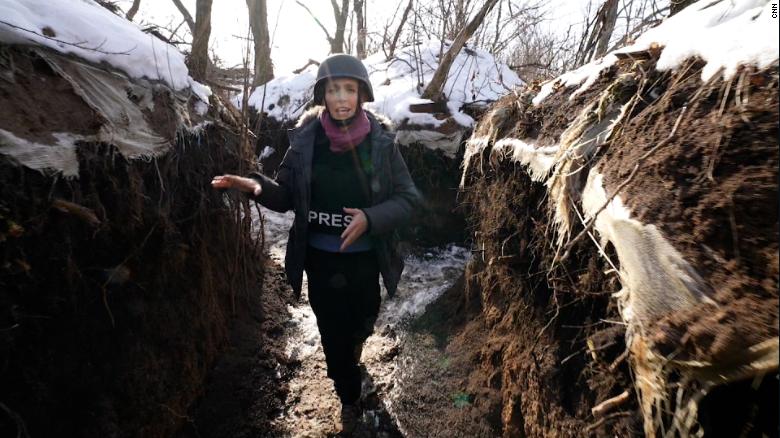In eastern Ukraine they don’t expect an invasion, but people are watching and waiting

The Russian border is less than 20 miles away. Beyond it, thousands of Russian troops have gathered, bringing with them tanks and other armor. But despite growing alarm in Washington at the prospect of an “imminent” Russian Close by, a young sergeant commands a handful of men in a defensive position set on a wooded ridge. The separatist lines are just a few hundred yards away, and there are daily exchanges of fire. One of the soldiers, Andrei, shows us a lookout position dug into a bank of rich, dark earth. He says the separatists frequently send drones up to scan the Ukrainian front lines. Moments later, an automatic grenade launcher fires a round towards the Ukrainian trenches, its detonation echoing across the fields. The soldiers take little notice, but the sergeant calls along the line, using an ancient field telephone, to check there are no casualties. The troops here have no two-way radios. The sergeant, who says he’d rather not give his name because his family is from Donbas — a region now partly held by the separatists — insists his men will be ready if there is a Russian offensive, despite what appear to be very basic defenses. “We are ready to meet any guests from Russia,” he tells CNN with a faint smile. “Our commanders told us that we must be aware, we must be ready.” Asked whether there’s any heavy weaponry to confront Russian armor, he says: “You don’t need to see it and the enemy doesn’t need to see it. But we have everything. No need to worry.” One problem for the Ukrainians is that under the terms of a truce agreement with the rebels, neither side can bring heavy weapons such as anti-tank missiles to the front lines. In the event of a lightning Russian offensive, that would put the Ukrainians at a severe disadvantage. The sergeant is confident he won’t see any “Russian guests.” He thinks the risk of an invasion is exaggerated. But if he’s wrong, this is perfect tank country: Rolling countryside uninterrupted by rivers or other natural barriers. If the Ukrainians’ thin defenses around these villages were to give way, Russian armor would likely be on the outskirts of the port of Mariupol — a city of half a million people — within hours. ‘Everything is normal’Like the soldiers, the people of Mariupol don’t expect an invasion. There is no sense of heightened alert, no westward exodus of civilians on the overnight train to Kyiv. Instead, life goes on as usual: Families brave the cold to go ice-skating in Teatralnyi square or wander along the pier clutching hot drinks. The city’s massive steel plants belch noxious smoke out over Mariupol’s suburbs, and in the central market, the stalls are well stocked. Natalya, who runs a stall selling sausages, is optimistic there won’t be conflict. “We have children and grandchildren, and we don’t want war,” she says. “And there won’t be war. We believe that.” Erzhan, a Turkish citizen who has lived here 20 years and previously served on ocean-going freighters, now sells chicken in the market with his Ukrainian wife. “No, there will not be a war,” he says confidently. “People live well here, everything is normal. It’s only Biden who thinks this. Biden wants NATO to be here, and the Russians don’t want that.” Many people in Mariupol seem to accept the government’s appeal for calm — even as Western officials warn that a Russian attack against Ukraine is highly likely and could even begin this month. They can’t see what all the fuss is about. At the nearby Sava coffee stall, Nadia is serving up steaming flat whites. She is more worried about the latest Covid-19 surge in Ukraine than the prospect of war. On Saturday, Ukraine recorded its highest daily tally of new cases. As for any Russian threat, she shares a Mariupolian fatalism: “This is our home; we have nowhere else to go.””We have lived with this for eight years,” is the common refrain here — ever since pro-Russian separatists briefly occupied the city before they were driven back by Ukrainian forces. Back in 2014, there was a strong strand of pro-Russian sentiment in Mariupol. The city saw fighting in the streets. In some of the villages along the nearby border, now occupied by the rebels, Russian is the mother-tongue and the capital, Kyiv, is seen as a distant and alien place. But the demographics have changed. Mariupol’s population was swollen by Ukrainians who fled the rebel occupation and now shudder at the prospect of another war. All the more so because the standard of living here has improved, with European investment and government spending aimed at winning hearts and minds. Those are precious improvements that the people here want to protect. They know all too well what war looks and sounds like. At least thirty people were killed in a rocket attack that hit apartment blocks in January 2015. Several villages to the east of the city were destroyed by the fighting; eight years on, they still lie abandoned. Scarcely a house is untouched in the coastal village of Shyrokyne, their walls scarred and punctured by rocket fire. Whether out of disbelief or denial, the people here — and the soldiers tasked with defending them — cannot imagine a war that would be infinitely more destructive than the fighting that has already cost 15,000 lives and evicted many thousands more from their homes. So, they wait, and watch, and hope.







